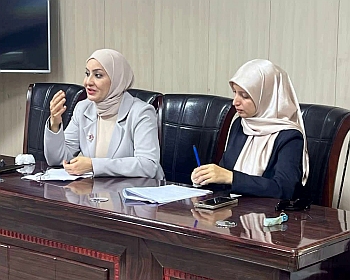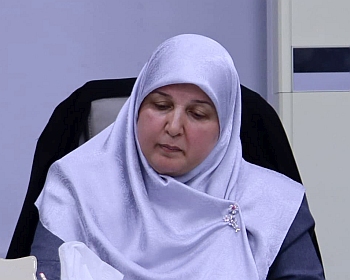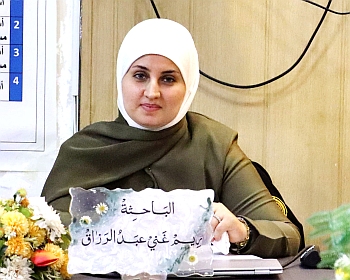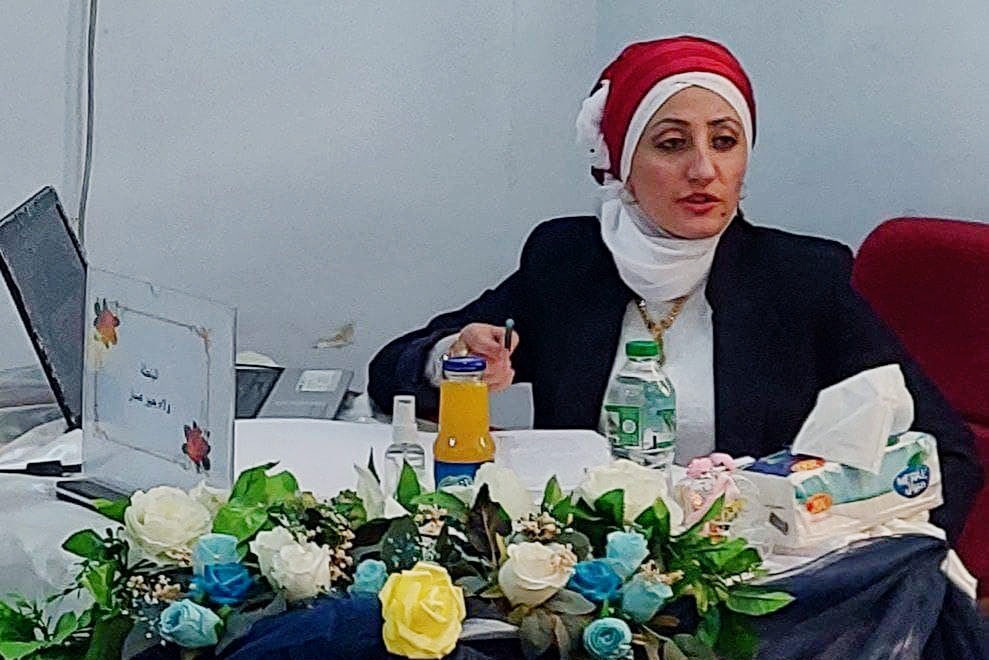 ناقش قسم الكيمياء في كلية التربية للعلوم الصرفة (ابن الهيثم) رسالة الماجستير الموسومة (تشخيص التعديل الكاربوني لطين عراقي واستعماله في مجال الامتزاز) للطالب (ولاء جبير صبار نصيف) التي انجزها تحت اشراف التدريسي في القسم (أ.م.د. أحـمـد محمد عباس) ونوقشت من قبل لجنة المناقشة المبينة أسمائهم فيما يأتي :
ناقش قسم الكيمياء في كلية التربية للعلوم الصرفة (ابن الهيثم) رسالة الماجستير الموسومة (تشخيص التعديل الكاربوني لطين عراقي واستعماله في مجال الامتزاز) للطالب (ولاء جبير صبار نصيف) التي انجزها تحت اشراف التدريسي في القسم (أ.م.د. أحـمـد محمد عباس) ونوقشت من قبل لجنة المناقشة المبينة أسمائهم فيما يأتي :
1- أ.د. ظافر تموين عجيل (رئيسا)
2- أ.م.د. عمار جاسم محمد (عضوا)
3- أ.م.د. عبد القادر حسين نعمة (عضوا)
4- أ.م.د. احمد محمد عباس (عضوا ومشرفا)
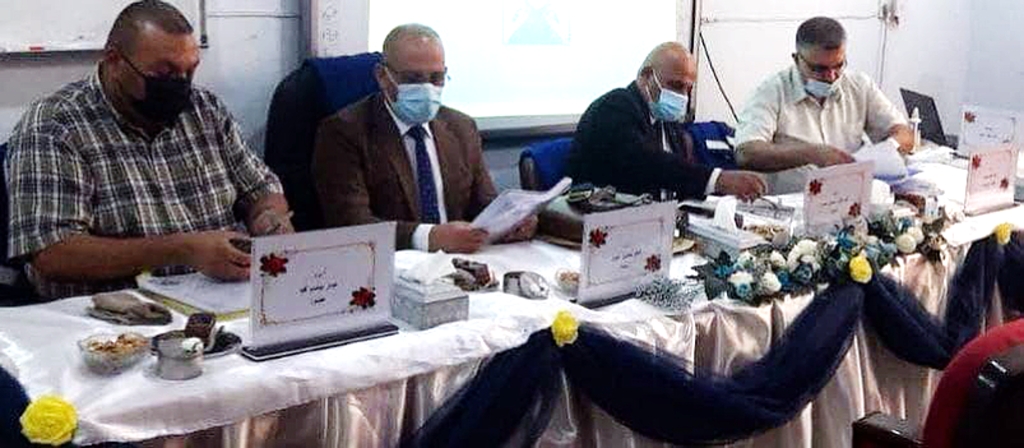
ويهدف هذا البحث الى :-
1- تهيئة سطح طين الفلنت ( FL ) كسطح اول وتحضير سطحين (ثاني وثالث) من طين الفلنت من خلال تنشيطه وتعديله بواسطة كاربون مادة الكلوكوز (سطح الثاني) ويرمز له ( FLG ) اما السطح الثالث تم تعديله بواسطة كاربون مادة الدكسترين ويرمز له ( FLD ) بهدف تحسين خواصه الامتزازية في امتزاز صبغة الجانوس الاخضر ( JG ) من محاليلها المائية , وتم اجراء تشخيص لطين الفلنت و سطوحها المعدلة بواسطة تقنيات التالية :- (FT-IR و XRD و FESEM و EDX ).
-
تعيين زمن الاتزان و اجراء دراسة حركية الامتزاز و تحديد طاقة التنشيط لعمليات امتزاز صبغة الجانوس الاخضر ( JG ) باستعمال السطوح المازة ( طين الفلنت و سطوحها المعدلة ) وتم المقارنة بين هذه السطوح .
3- تعيين الايزوثيرمات وحساب الدوال الثرموديناميكية لعملية امتزاز صبغة الجانوس الاخضر ( JG ) على السطوح المازة ( طين الفلنت و سطوحها المعدلة ) و اجراء مقارنة بين هذه السطوح .
-
دراسة بعض العوامل المؤثرة لعملية الامتزاز والاكثر ملائمة للظروف حيث تشمل ( وزن و حجم المادة المازة , تركيز المادة الممتزة , درجة الحرارة ) .
تناولت هذه الدراسة عملية تحسين كفاءة الامتزاز لطين الفلنت (FL) العراقي من خلال اجراء تعديلين على سطحه , الاول بتنشيط وتحميل طين الفلنت بواسطة كاربون كلوكوز (FLG) والثاني بتنشيط وتحميل طين الفلنت بواسطة كاربون دكسترين (FLD) .
وقد تم دراسة التغيرات التي طرأت على السطوح الثلاثة (FL,FLG,FLD) ومقارنتها من خلال عدد من التقنيات التالية مطياف الاشعة تحت الحمراء (FT-IR) وحيود الاشعة السينية (XRD) و المجهر الالكتروني الماسح ذو المجال المنبعث (FESEM) ومطيافية تشتت الطاقة بالاشعة السينية (EDX) .
وتم دراسة قابلية السطوح الثلاثة (FL,FLG,FLD) على امتزاز صبغة الجانوس الاخضر (JG) من محلولها المائي كنموذج لأحدى المواد التي تسبب تلوث المياه إذ تم دراسة عدد من العوامل التي تؤثر في قابلية الامتزاز مثل ( وزن المادة المازة و حجم دقائق المادة المازة و زمن التماس و درجة الحرارة و تركيز الابتدائي للمادة الممتزة ) , إذ تم اجراء الدراسة الحركية لعملية امتزاز الصبغة وجد ان زمن الاتزان لامتزاز صبغة (JG) على سطح طين الفلنت (FL) هو 90 دقيقة اما السطح الثاني (FLG) والثالث (FLD) هو 45 دقيقة إذ وجد ان قابلية الامتزاز تزداد مع زيادة درجة الحرارة لجميع السطوح المذكورة اي ان عملية الامتزاز ذات طبيعة ماصة للحرارة , وتبين من الدراسة الحركية ان النموذج الحركي للمرتبة الثانية الكاذبة اكثر ملاءمة من النماذج الحركية الاخرى لعملية امتزاز الصبغة (JG) على السطوح, وبالاعتماد على قيم طاقة التنشيط للسطوح الثلاثة والتي كانت اقل من (40 kJ/mol) مما يدل على ان نوع الامتزاز هو امتزاز فيزيائي , كذلك تم تطبيق عدد من ايزوثيرمات الامتزاز مثل (لانكماير, فرندليش ,تمكن ) لهذه الدراسة إذ وجد ان عملية امتزاز الصبغة (JG) على السطوح الثلاث تتبع نموذج لانكماير اكثر من الايزوثيرمات الاخرى .
تم ملاحظة ان اعلى نسبة امتزاز للصبغة على السطح (FL ) تساوي (%48.8473) وللسطح ( FLG ) تساوي (57.7935%) وللسطح ( FLD ) تساوي (69.2774%) ونستنتج مما تقدم ان افضلها كفاءة في امتزاز صبغة (JG) هو السطح الثالث ( FLD ).
تم حساب الدوال الثرموديناميكية لعملية امتزاز صبغة (JG) على السطوح الثلاثة إذ وجد ان قيم طاقة كبس الحرة (ΔG) موجبة مما يدل على صعوبة امتزاز الصبغة (JG) على السطح ( FL) بينما تكون قيم (ΔG) موجبة وتصبح سالبة مع زيادة درجة الحرارة مما يدل على سهولة عملية امتزاز الصبغة على السطوح الاخرى مع زيادة درجة الحرارة.
كما نلاحظ ان عملية الامتزاز تكون ذات طبيعة ماصة للحرارة وذلك لكون المحتوى الحراري او الانثالبي (ΔH) لامتزاز صبغة (JG) لكل السطوح تكون قيمتها موجبة وعند جميع درجات الحرارة ,اما التغير في الانتروبي ((ΔS لعملية امتزاز صبغة (JG) على سطوح (FL,FLG,FLD) كانت قيمتها موجبة مما يدل على إن عملية امتزاز جزيئات الصبغة تكون غير منتظمة .
بعد أجراء هذه الدراسة ومن اجل استمرار العملية البحثية العلمية تم وضع بعض التوصيات والمقترحات نوصي بها الباحثين لغرض تنفيذها فيما بعد :-
1- اعادة الدراسة باستخدام تاثير عوامل اخرى مثل شدة ايونية و قيم pH .
2- اجراء التعديل على سطح طين الفلنت بمواد نانوية .
3- اجراء دراسة اخرى لامتزاز صبغة الجانوس الاخضر على السطوح قيد الدراسة ولكن باستعمال الطريقة المستمرة ( طريقة العمود ).
4- تنشيط وتعديل طين الفلنت بواسطة الحوامض او القواعد اولا وبعدها يتم أجراء تنشيط وتحميل بواسطة كاربون كل من ( مصادر متنوعة ) والمقارنة مع الدراسة الحالية من خلال التغيرات الناتجة والقابلية الامتزازية .
5- استعمال السطوح ( FL,FLG,FLD ) في هذه الدراسة لامتزاز صبغات اخرى او ملوثات اخرى مثل الفينولات ومعوضاتها او العناصر الثقيلة مثل الزئبق و الألمنيوم و المنغنيز و غيرها من الملوثات .
Characterization of Carbomodification for Iraq Clay and uses in Adsorption Field
By Wala’a Jubair Sabbar Nasif
Supervised by Asst.prof.Ahmed Mohammed Abbas
This research aims to
– Preparation of the surface of flint clay (FL) as the first surface and the preparation of two surfaces (second and third) of flint clay by activating and modifying it by the carbon of glucose (the second surface) and symbolized by (FLG), while the third surface was modified by carbon of dextrin and symbolized by (FLD) In order to improve its adsorption properties in the adsorption of green janus (JG) dye from its aqueous solutions, a diagnosis of flint clay and its modified surfaces was carried out using the following techniques
. (FT-IR و XRD و FESEM وEDX )
– Determining the equilibrium time, conducting an adsorption kinetics study, and determining the activation energy for adsorption processes of janus green dye (JG) using the adsorbent surfaces (flint clay and its modified surfaces), and the comparison was made between these surfaces.
– Determining the isotherms and calculating the thermodynamic functions of the adsorption process of Janus green dye (JG) on the adsorbent surfaces (flint clay and its modified surfaces) and making a comparison between these surfaces.
– Studying some of the factors affecting the adsorption process that are most suitable for the conditions, including (weight and volume of the adsorbent, concentration of the adsorbent, temperature).
Abstract
This study deals with the process of improving the adsorption efficiency of Iraqi flint (FL) clay by making two modifications on its surface, the first by activating and loading flint clay by carbon glucose (FLG) and the second by activating and loading flint clay by carbon dextrin (FLD).The changes in the three surfaces (FL, FLG, FLD) were studied and compared by using the following techniques: infrared spectroscopy (FT-IR), X-ray diffraction (XRD), Field Emission Scanning Electron Microscopy (FESEM) and Energy-dispersive X-ray spectroscopy(EDX).
The ability of the three surfaces (FL, FLG, FLD) to adsorb Janus Green (JG) from its aqueous solution was studied as a sample for one of the substances that cause water pollution. A number of factors that affect the ability of adsorption have been studied, such as (weight of the adsorbent, particles size of the adsorbent, contact time, temperature, and the initial concentration of the adsorb ate).
Where the kinetic study of the dye adsorption process was conducted, it was found that the equilibrium time for the adsorption of dye (JG) on the surface of flint clay (FL) is 90 min, while the second surface (FLG) and the third (FLD) is 45 min, where it was found that the adsorption capacity increases with increasing temperature. For all of the above-mentioned surfaces, the adsorption process is endothermic in nature. It was found from the kinetic study that the kinetic model of the pseudo second order is more suitable than the rest of the kinetic models of the adsorption process of dye (JG) on the surfaces, and depending on the values of the activation energy of the three surfaces, which was less than (40 kJ/mol), which indicates that the adsorption type is physical adsorption.
Also, a number of adsorption isotherms such as (Langmuir, Freundlich, Temkin) were applied for this study, where it was found that the process of dye adsorption (JG) on the three surfaces follows the Langmuir model more than other isotherms.It was noted that the highest adsorption rate of the dye on the surface (FL) is (48.8473%), for the surface FLG) is (57.7935%) and for the surface (FLD) it is (69.2774%) and we conclude that the best Adsorption efficiency in JG is the third surface (FLD).
The thermodynamic functions of the dye adsorption process (JG) were calculated on the three surfaces, where it was found that the values of the free compressive energy (ΔG) are positive, which indicates the difficulty of dye adsorption (JG) on the surface (FL), while the values of (ΔG) are positive and become negative with increasing temperature, which indicates the ease of the dye adsorption process on other surfaces with increasing temperature.
We also note that the adsorption process is an endothermic nature, because the change in enthalpy (ΔH) for adsorption of JG dye on all surfaces is positive and at all temperatures. As for the change in entropy (ΔS) for the dye adsorption process (JG) on the surfaces of (FL, FLG, FLD) its value was positive, which indicates that the adsorption process of dye molecules is irregular
The recommendations
After conducting this study and in order to continue the scientific research process, some recommendations and proposals were developed that we recommend to researchers for the purpose of implementing them later
– Re-study using the influence of other factors such as ionic strength and pH values.
– Making the modification on the surface of the flint clay with nanomaterials.
– Conducting another study for the adsorption of janus green dye on the surfaces under study, but using the continuous method (column method).
– Activation and modification of flint clay by acids or bases first, and then activation and loading are carried out by carbon from (various sources) and compared with the current study through the resulting changes and adsorption capacity.
– The use of surfaces (FL, FLG, FLD) in this study to adsorb other dyes or other pollutants such as phenols and their substitutes or heavy elements such as mercury, aluminum, manganese and other pollutants.


